Fintech in Germany Market Size
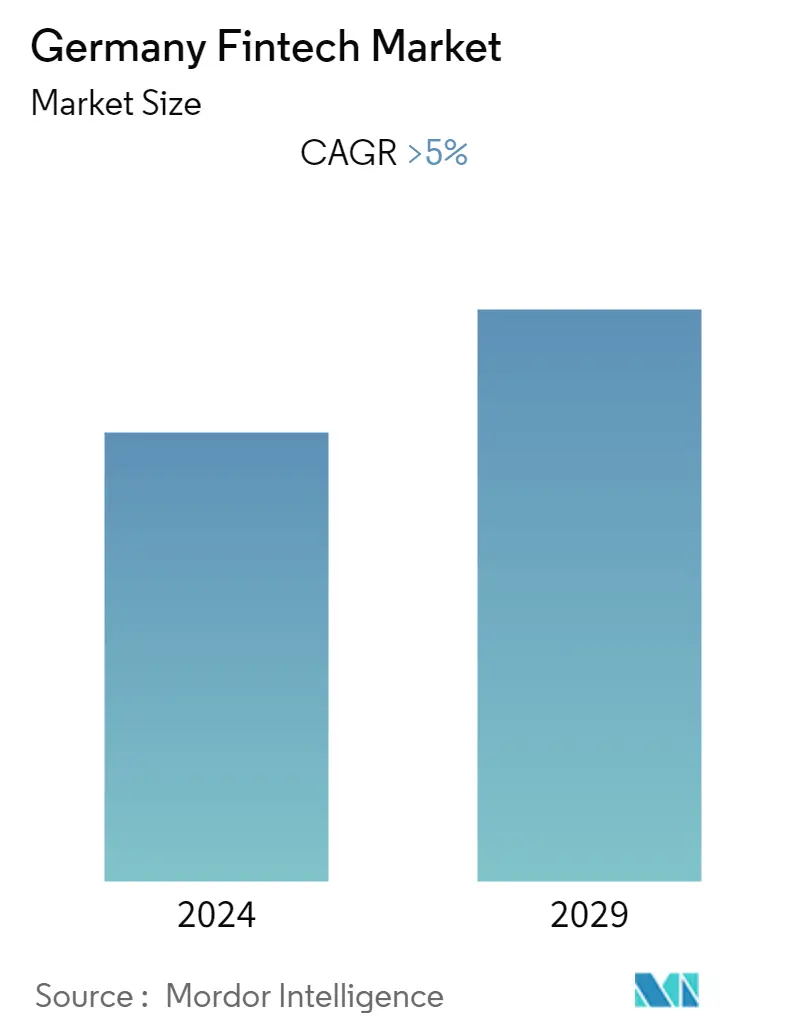
| Study Period | 2019 - 2029 |
| Base Year For Estimation | 2023 |
| Forecast Data Period | 2024 - 2029 |
| Historical Data Period | 2019 - 2022 |
| CAGR | > 5.00 % |
| Market Concentration | Medium |
Major Players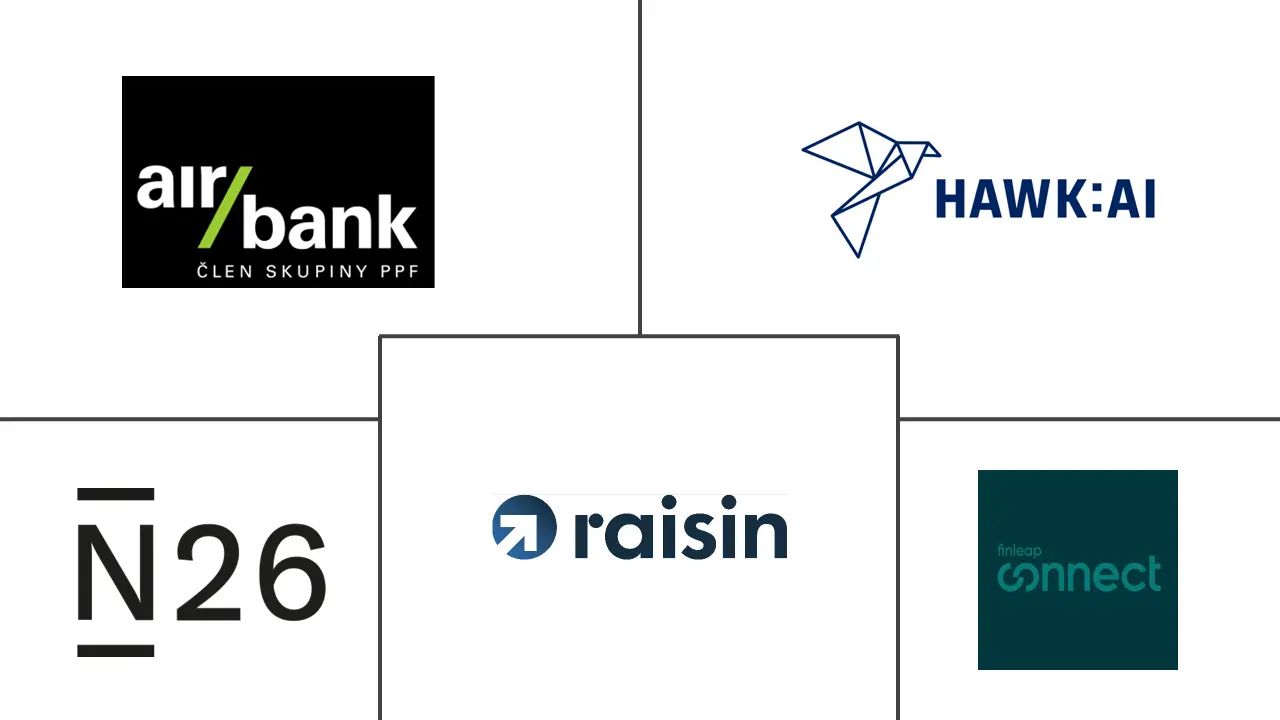
*Disclaimer: Major Players sorted in no particular order |
Fintech in Germany Market Analysis
The Germany Fintech market is expected to register a CAGR of 5% in the forecast period.
Fintech adoption rates are growing around the world. According to EY, 64 percent of global consumers use Fintech, with a rate as high as 87 percent in China and India. Fintech adoption in Germany almost doubled during 2017-18, with German use now at the same level as the global average. German banking licenses are strictly regulated by the Federal Financial Supervisory Authority, Bafin. Fintech founders have reported difficulties while applying for a banking license and navigating the stringent regulations to enter the marketplace.
The COVID-19 pandemic and the corresponding health measures changed customer behavior immensely. As people sought to make less physical contact, the demand for contactless paying services grew strongly in 2020. According to Germany Trade and Invest, 43% of Germans changed their payment method to cashless options to avoid human contact. Even small retail shops that in the past only accepted cash switched to contactless payments for hygiene reasons. However, only 8% of German consumers preferred mobile payment options to classic card payments.
Nevertheless, in 2020, because of a struggling economy due to the impact of Covid-19, investment in Fintech's worldwide went down. According to a KPMG report on global Fintech, the total investment from private equity, M&A, and venture capital, was around USD 150 billion in 2019, whereas in 2020, only USD 26 billion were invested globally. As the international economy is recovering, investments are expected to rise back to the level of 2019.
The innovative technologies and disruptive business models are removing market entry and expansion barriers, with German Fintech looking to expand beyond Germany and international Fintech also entering the German market. Almost three-quarters of foreign Fintechs are active in the Banking and Lending, Payments, and Enabling Processes & Technology segments.
Fintech in Germany Market Trends
Increase in Investments in Fintech Sector is Fueling the Market
Germany's banking sector secured the most Fintech investment in 2021. Total Fintech investment in the EMEA region grew to a record USD 77 billion in 2021, driven partly by significant M&A activity. For instance, Germany's N26 raised USD 470 million from two separate deals, and U.K. neo banks Monzo and Starling Bank raised USD 144 million and USD 211 million, respectively, the latter from two separate transactions. The German Fintech is second-ranked in Europe for investment which raised EUR 2.1 Billion. This investment will help the Fintech sector grow and tap into a more potential market.
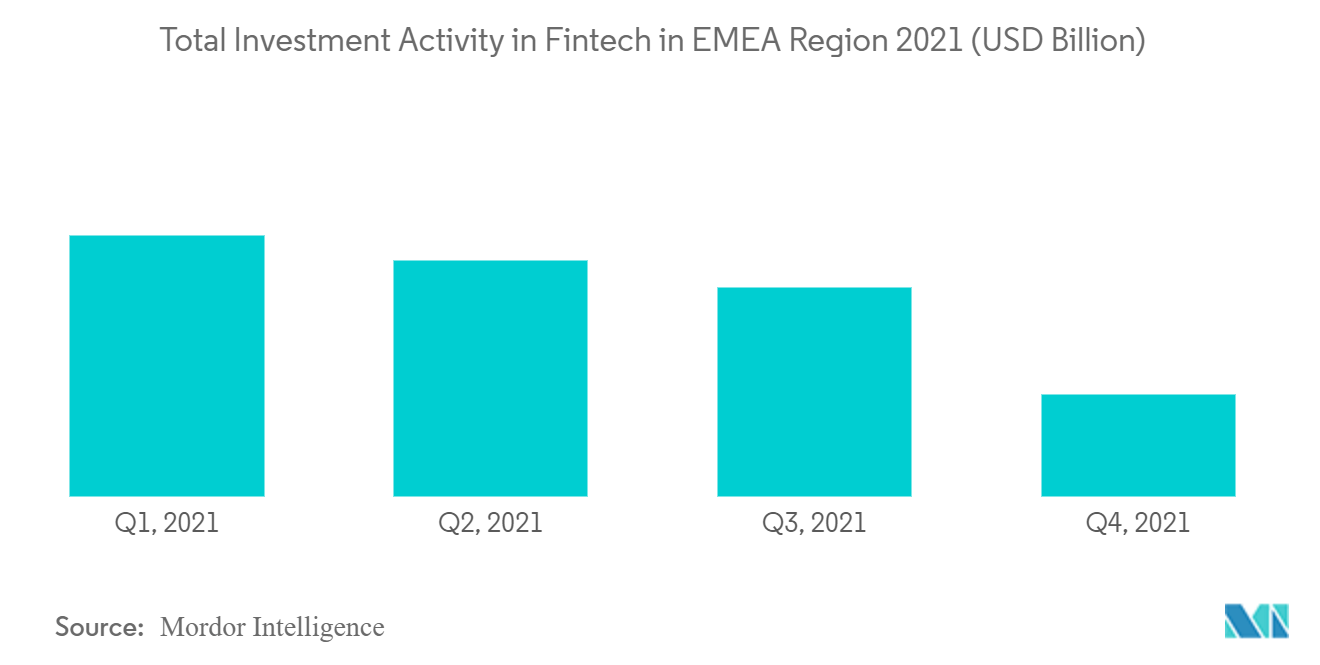
Merger and Acquisition Activity and Startups are Driving the Market
Germany is one of the leading European countries for Fintech. Startups are the driver for innovation in the sectors such as Fintech. In September 2021, more than 190 startups were targeting finance and Fintech. German FinTech funding is projected to reach USD 4.2 billion in 2022. In 2021 investment peaked at USD 6.4 billion. Deal activity in Germany is recorded as 272 deals in total for 2022. These activities are expected to boost the growth of the Fintech sector in Germany and further strengthen the roots in the market.
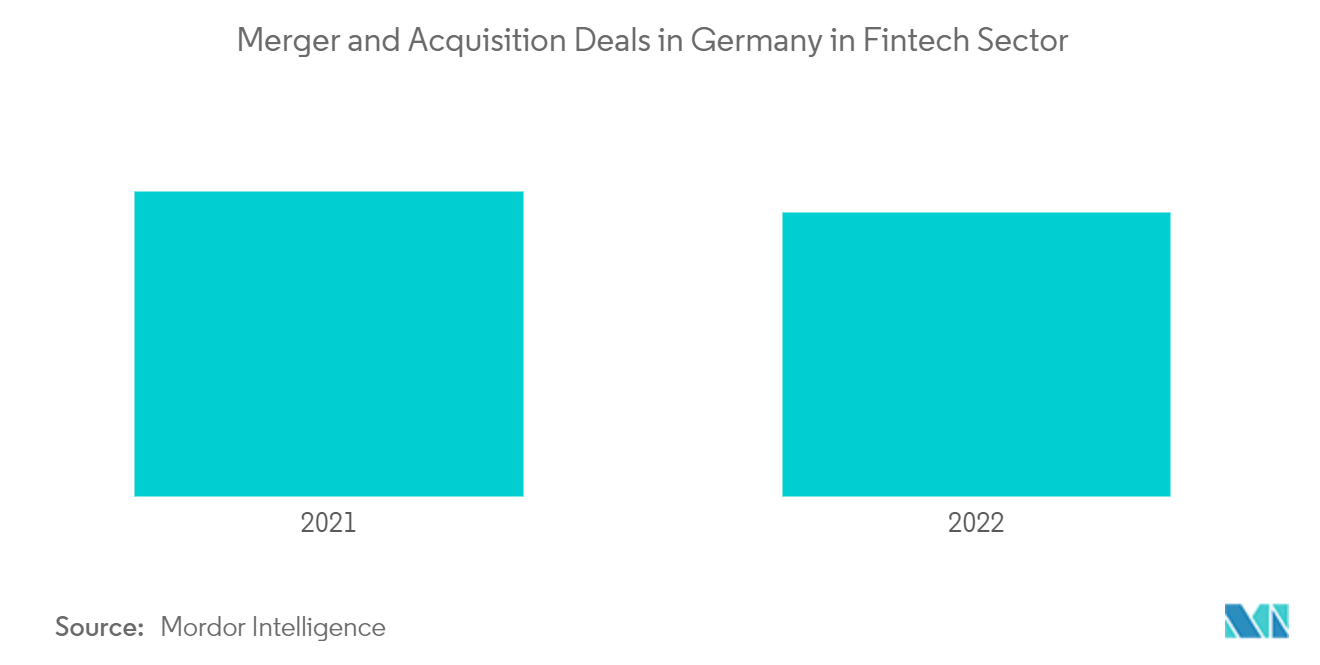
Fintech in Germany Industry Overview
Companies across the world have considerable investments in this segment of the market. In Germany, the Fintech market has many companies fragmented over minor shares. Adopting the Fintech platform and up-gradation to new Technology leads to increasing competition amongst the company. Innovation and technological advancement are taking pace as COVID-19 and urbanization strike general people to adopt the new ease of payment and contactless payment gateways. The key players in the market include AirBank, Hawk: AI, Finleap Connect, Raisin DS, and N26.
Fintech in Germany Market Leaders
-
AirBank
-
Hawk:AI
-
Finleap Connect
-
Raisin DS
-
N26
*Disclaimer: Major Players sorted in no particular order
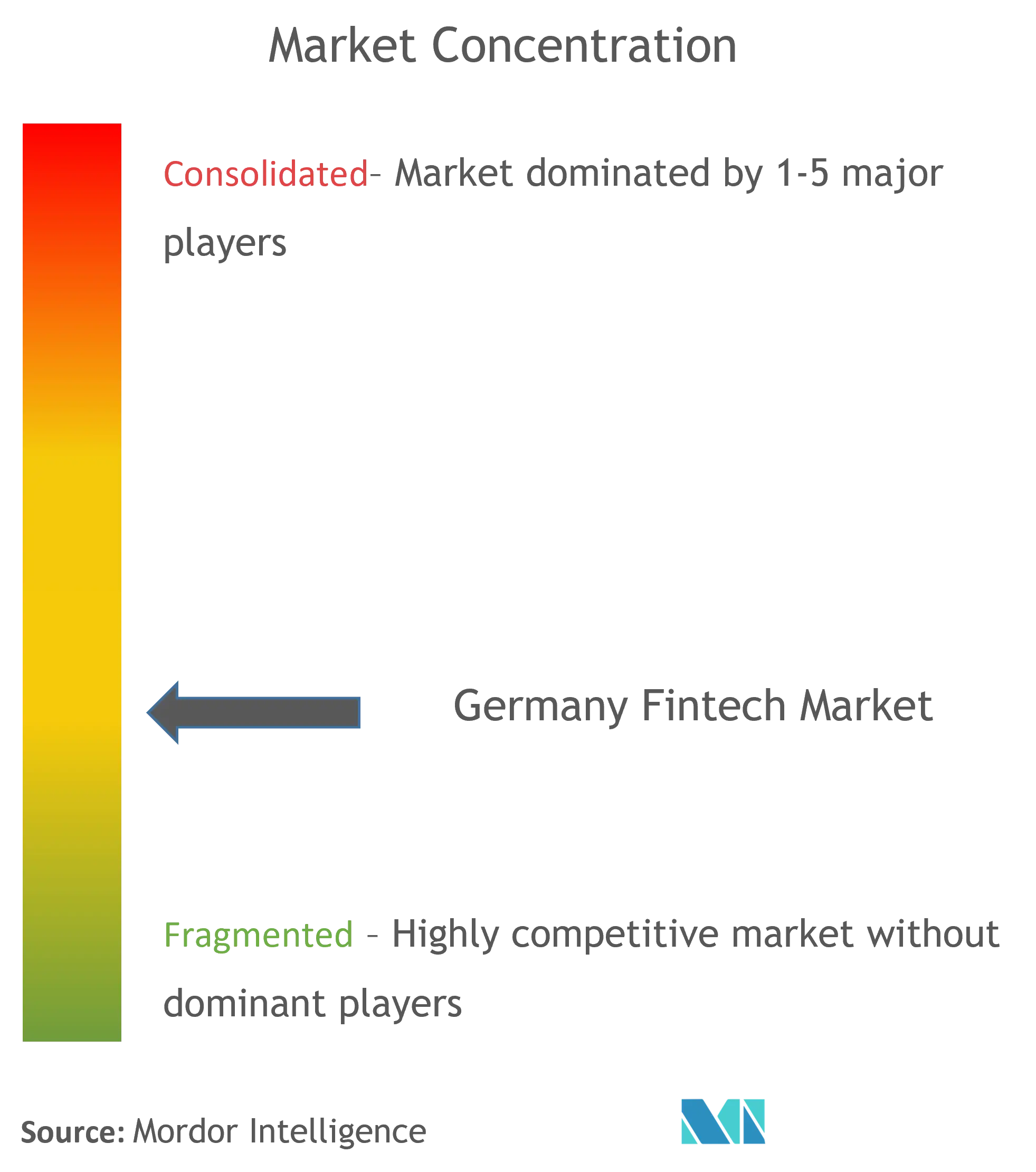
Fintech in Germany Market News
- June 2022: Airbank raised USD 20 million to make a comprehensive global SMB banking solution. The firm is focused on enabling real-time cash flow management instead of forcing small to medium-sized businesses (SMBs) to rely on weekly or monthly reporting to gain financial insights. This funding will help the company to expand its operation and capture more market share.
- March 2022: German investing and deposit marketplace Raisin DS added a new asset class to its lineup in the form of private equity. The addition means that Raisin now offers deposits and savings via its marketplace of accounts across Europe. This will help the company capture more market share.
Fintech in Germany Market Report - Table of Contents
1. INTRODUCTION
1.1 Study Assumptions and Market Definition
1.2 Scope of the Study
2. RESEARCH METHODOLOGY
3. EXECUTIVE SUMMARY
4. MARKET INSIGHTS AND DYNAMICS
4.1 Market Overview
4.2 Market Drivers
4.3 Market Restraints
4.4 Value Chain / Supply Chain Analysis
4.5 Industry Attractiveness - Porter's Five Forces Analysis
4.5.1 Threat of New Entrants
4.5.2 Bargaining Power of Buyers/Consumers
4.5.3 Bargaining Power of Suppliers
4.5.4 Threat of Substitute Products
4.5.5 Intensity of Competitive Rivalry
4.6 Insights on Latest Trends and Technological Innovations in the Industry
4.7 Impact of COVID-19 on market
5. MARKET SEGMENTATION
5.1 By Service proposition
5.1.1 Digital Payments
5.1.1.1 Digital Commerce
5.1.1.2 Mobile POS Payments
5.1.2 Digital Capital Raising
5.1.2.1 Crowdfunding
5.1.2.2 Crowdinvesting
5.1.2.3 Crowdlending
5.1.3 Digital Investment
5.1.3.1 Robo-Advisors
5.1.3.2 Neobrokers
5.1.4 NeoBanking
5.1.5 Digital Assets
5.1.5.1 Cryptocurrencies
5.1.5.2 NFT
6. COMPETITIVE LANDSCAPE
6.1 Market Concentration Overview
6.2 Company Profiles
6.2.1 AirBank
6.2.2 Hawk:AI
6.2.3 Finleap Connect
6.2.4 OneFor
6.2.5 Raisin DS
6.2.6 N26
6.2.7 Wefox Group
6.2.8 NeuFund
6.2.9 Mambu
6.2.10 HoneyBook
6.2.11 Trade Republic
- *List Not Exhaustive
7. MARKET OPPORTUNITIES AND FUTURE TRENDS
8. DISCLAIMER AND ABOUT US
Fintech in Germany Industry Segmentation
Fintech is one of the most widely demanded products as people adopt urbanization. A complete background analysis of the Germany Fintech Market includes an assessment of the economy, a market overview, market size estimation for critical segments, emerging trends in the market, market dynamics, and critical company profiles covered in the report. The Germany Fintech Market is segmented by service proposition (Digital Payments (Digital Commerce & Mobile POS Payments), digital capital raising (Crowdfunding, Crowdinvesting, & Crowdlending), digital investment (Robo-Advisors & Neobrokers), Neobanking, digital assets (Cryptocurrencies & NFT), and others). The report offers market size and forecasts in value (USD million) for all the above segments.
| By Service proposition | |||||
| |||||
| |||||
| |||||
| NeoBanking | |||||
|
Fintech in Germany Market Research FAQs
What is the current Germany Fintech Market size?
The Germany Fintech Market is projected to register a CAGR of greater than 5% during the forecast period (2024-2029)
Who are the key players in Germany Fintech Market?
AirBank, Hawk:AI, Finleap Connect, Raisin DS and N26 are the major companies operating in the Germany Fintech Market.
What years does this Germany Fintech Market cover?
The report covers the Germany Fintech Market historical market size for years: 2019, 2020, 2021, 2022 and 2023. The report also forecasts the Germany Fintech Market size for years: 2024, 2025, 2026, 2027, 2028 and 2029.
Fintech in Germany Industry Report
Statistics for the 2024 Fintech in Germany market share, size and revenue growth rate, created by Mordor Intelligence™ Industry Reports. Fintech in Germany analysis includes a market forecast outlook to 2029 and historical overview. Get a sample of this industry analysis as a free report PDF download.



